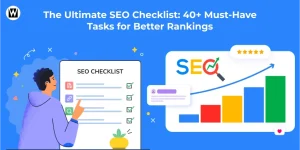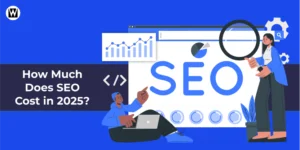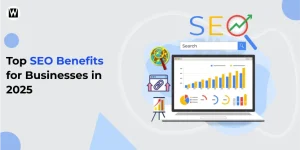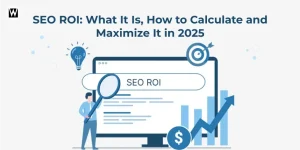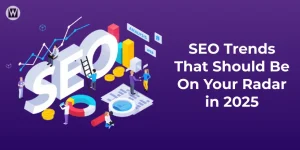SEO vs PPC: 5 Key Differences
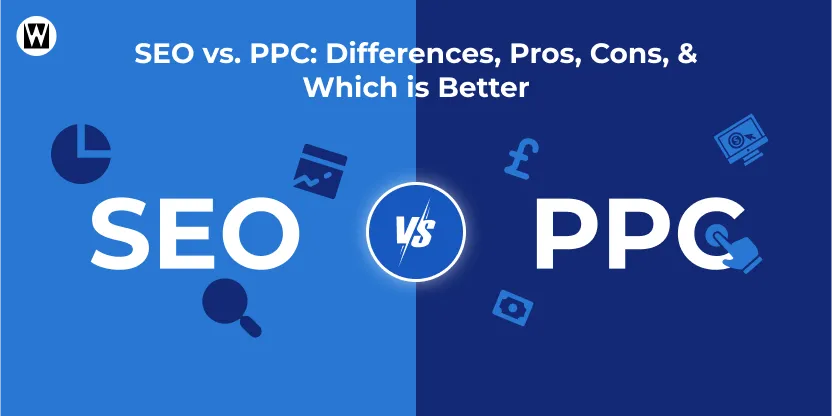
SEO and PPC are the two most dominant strategies in Digital Marketing. Both are potent methods for increasing traffic and visibility, but they are not the same, and their purposes are different. SEO helps your business grow naturally over time, whereas you can get immediate results with paid advertising through PPC.
Understanding the differences between SEO and PPC marketing is important for businesses looking to optimize their online presence.
At WebyKing, we believe in making informed decisions that are right for your unique goals. In this blog, we will discuss the five differences between SEO and PPC so you can use each to its maximum potential and determine which one works best for your marketing strategy. Let’s get started.
What is SEO?
SEO (Search Engine Optimization) is the practice of optimizing your website to rank higher on search engine result pages (SERPs). It’s all about making your site more visible and accessible to people searching for content, products, or services like yours. Here’s a quick breakdown:
| Types | Particulars |
|---|---|
| On-page SEO | Optimizing content with relevant keywords and improving UX with fast speed and mobile-friendly design. Proper title tags, meta descriptions, and clean URLs help search engines crawl your site quickly. |
| Off-page SEO | High-quality backlinks and engaging on social media channels to foster credibility and visibility. Guest blogging and influencer outreach help build valuable external connections. |
| Local SEO | Targeting local keywords and optimizing your Google My Business profile for “near me” searches. Encouraging reviews and creating location-based content increases relevance and trust. |
What is PPC?
PPC (Pay-per-click) is an advertising model in which you pay each time someone clicks on your ad. It’s one of the quickest ways to drive targeted traffic to your website, and when done right, it can yield a great return on investment (ROI).
Unlike SEO, which takes time to build a brand, PPC can deliver instant results, making it a good option for businesses looking to boost visibility quickly.
| Types | Particulars |
|---|---|
| Google Ads | Google Ads is the most popular PPC platform, allowing you to run ads on Google’s search engine results and across its partner network. |
| Bing Ads | Bing Ads is another great platform, though it’s smaller than Google Ads. While the audience is smaller, it’s often less competitive, meaning you can get lower costs per click and still drive targeted traffic. |
| Social Media Ads | Platforms like Facebook, Instagram, LinkedIn, and Twitter are ideal for PPC. Social media ads allow you to target audiences based on interests, demographics, and preferences, offering a more personalized approach. |
PPC allows you to control your advertising budget and campaign goals, which is why it’s a top choice for many brands looking to scale quickly. It’s all about getting the right message in front of the right audience at the right time.
5 Key Differences Between SEO and PPC
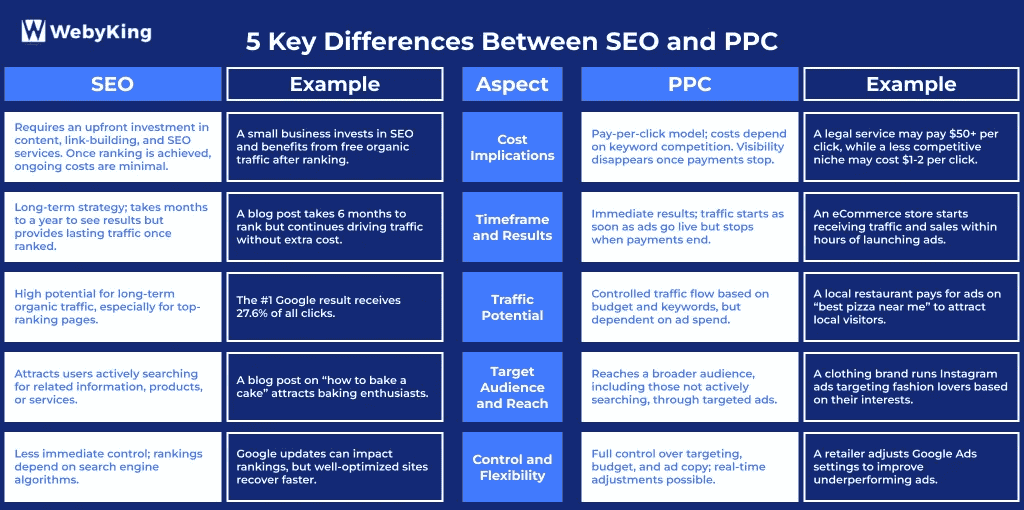
SEO and PPC are powerful tools that can help drive traffic and engagement to your website. Although they are comparable in the sense that they both aim to increase your website’s visibility, they accomplish this in disparate ways and complement one another beautifully.
Search engine optimization (SEO) is about ranking your website higher than your competitors organically, whereas pay-per-click (PPC) advertising allows you to pay for immediate visibility both on search engines and other platforms. To elaborate on this a bit, you can see the image given below as an example.
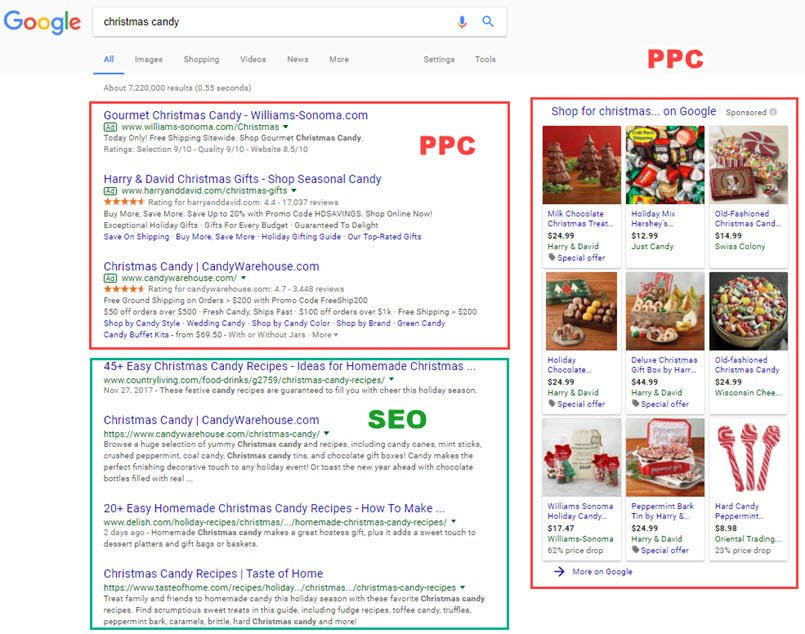
Source: WordStream
Imagine you are searching for “Christmas Candy”.
- When you look at the search results, the first listings you will see are the PPC ads marked as “sponsored“.
- Right beside them, you will see the organic results – websites that have earned their rankings through SEO.
As you can see, the paid ads get immediate visibility at the top, while the organic listing builds up over time. Now that we understand the difference between SEO and PPC marketing let’s explore what sets them apart.
Cost Implications
SEO: SEO typically requires a long-term investment, as it focuses on organic ranking. While there are no direct costs for clicks, it often involves expenses for content creation, link-building, and professional SEO services. The investment is upfront, but once you rank, the ongoing costs are minimal.
For instance, a small business owner may spend several months optimizing its website, but once it starts ranking, it can benefit from free, organic traffic without paying for clicks. However, the upfront cost of hiring an SEO expert or content team is something to consider.
PPC: With PPC, you pay for every click. The cost per click can vary depending on the competition in your industry and the keywords you target. It provides more immediate results, but once you stop paying, your visibility drops instantly.
In highly competitive markets, such as legal services, the cost per click on Google Ads can be as high as $50+, while in less competitive markets, it may be as low as $1-2.
Timeframe and Results
SEO: SEO is a slow-burn strategy that takes time to show results. It can take anywhere from a few months to a year to see significant improvements in rankings and traffic. However, once you reach the top positions, they tend to stay there longer if maintained.
A blog post optimized for a specific keyword may take 6 months to rank on the first page of Google, but once it gets there, the traffic will continue to flow without additional costs.
PPC: PPC delivers immediate results as soon as your ads are alive. You can start driving traffic in minutes, but the moment you stop paying, your ads disappear. It’s great for short-term goals, like promotions or product launches.
For instance, a new eCommerce store running Google Ads might start seeing traffic and sales within hours of launching their campaign, but they must continuously pay to keep the ads running.
Traffic Potential
SEO: Organic traffic can be significant in the long term, especially for high-traffic keywords. Once your website achieves a top position on the first page of search results, you can attract a steady flow of visitors without having to pay for each click.
According to Backlinko, the #1 result on Google receives 27.6% of all clicks, with the top three results capturing the majority of clicks.
PPC: Pay-per-click advertising provides more targets and a managed flow of traffic. You can generate as much or as little traffic as you desire based on your budget and the keywords you choose. However, if your budget is limited, the traffic will be restricted.
For instance, a local restaurant might focus on particular local keywords, such as “best pizza near me,” and only pay for clicks from individuals who are likely to visit.
Target Audience and Reach
SEO: SEO targets users actively searching for information, products, or services related to your business. It is effective for building brand authority and attracting users who are in the research or decision-making phase.
For example, if someone searches for “how to bake a cake,” an SEO-optimized blog about cake recipes can draw in people interested in baking.
PPC: PPC ads enable you to reach a wider audience, including those who may not be actively searching for your product but could still be interested based on demographics, behaviors, or preferences. It’s ideal for brand awareness and reaching new audiences.
For instance, a clothing brand can run Instagram ads targeting individuals who have shown an interest in fashion, even if they’ve never searched for a specific brand.
Control and Flexibility
SEO: SEO offers less immediate control because results depend on search engine algorithms, which are constantly evolving. Once you rank, though, you have more long-term control over maintaining that position.
For instance, Google’s algorithm changes can impact rankings unpredictably, but if you’ve done your SEO work well, you can usually recover from updates faster than competitors who haven’t optimized.
PPC: PPC offers more control and flexibility in terms of targeting, budget, and ad copy. You can adjust your campaigns daily and see real-time results, making it easier to fine-tune strategies.
For example, a retailer running Google Ads can easily change the targeting, ad copy, and budget if they notice a specific ad isn’t performing well.
In summary, SEO and PPC have advantages, and when used together, they can complement each other to maximize traffic, engagement, and conversions.
SEO and PPC: What Are the Similarities?
Both SEO and PPC strategies are designed to increase visibility and drive traffic to your website. While they differ in their approach, SEO focuses on organic rankings, and PPC involves paid ads that work toward the same goal: attracting more relevant visitors.
When used together, SEO and PPC can complete each other, allowing small businesses to build long-term authority through SEO while also gaining immediate traffic through PPC. Here’s a look at the similarities between the two strategies:
|
By understanding these shared traits, small businesses can decide whether to focus on SEO, PPC or combine both for a practical digital marketing approach.
When to Choose SEO vs PPC: Making the Right Decision for Your Business
Deciding between SEO and PPC advertising can be a tough call for businesses. Both strategies have their unique advantages, but knowing when to choose each one is key to maximizing your marketing efforts. The right approach depends on factors like your business goals, budget, timeline and competition.
Let’s break down when it’s best to choose SEO or PPC based on your specific needs:
Choose SEO when:
- You want long-term, sustainable traffic without constantly paying for ads.
- Your goal is to build organic search rankings and gain visibility over time.
- You have a limited advertising budget and prefer a more cost-effective approach.
- You’re focusing on creating valuable content that naturally attracts customers.
- Your business is aiming for a steady, consistent flow of visitors rather than a quick boost.
Choose PPC when:
- You need immediate results and traffic within a short time frame.
- You’re promoting time-sensitive offers or events that need quick visibility.
- Your business has a larger budget for paid advertising and can afford ongoing costs.
- You’re looking to target very specific audiences with precise keywords or demographics.
- You want to test different keywords and ad creatives to see what works best before investing more in organic SEO.
By understanding your business goals and where you are in your marketing journey, you can make the right choice between SEO and PPC and take advantage of both strategies in a complementary way.
Key Takeaways
SEO and PPC are like peanut butter and jelly -separate, they are great, but together, they are unbeatable! To get the best of both worlds and create a robust digital marketing strategy, it’s essential to strike the right balance.
Whether you want the long-term benefits of SEO or the instant results of PPC, combining both can supercharge your online presence.
Let an experienced digital marketing company help you navigate the best of both worlds and get the results you deserve.
Frequently Asked Questions on Shopify Migration
How can SEO and PPC work together to improve results?
SEO builds long-term organic traffic, while PPC provides immediate visibility. Together, they create a well-rounded strategy that drives instant and sustainable results.
Can small businesses benefit from both SEO and PPC strategies?
Absolutely! Small businesses can maximize their online visibility and reach by combining SEO for organic growth and PPC for quick results.
Is PPC more effective for local businesses than SEO?
PPC allows local businesses to target specific demographic areas with precise ads, effectively driving immediate traffic. SEO builds a long-term local presence.
Does SEO require a more significant initial investment than PPC?
SEO often involves upfront costs for content creation and optimization, but it tends to have lower ongoing costs than PPC, which requires continuous ad spend.
How does PPC help in keyword research for SEO?
Running PPC campaigns can provide valuable insights into which keywords perform well, helping inform and refine SEO strategies for better organic results.
Can PPC help businesses in highly competitive industries where SEO is tricky?
Yes, PPC can provide visibility in competitive markets where ranking organically through SEO is difficult or time-consuming. It offers a quicker path to reach the target audience.
Does SEO traffic convert better than PPC traffic?
SEO traffic tends to be more cost-effective and can result in higher-quality leads, as users trust organic results more, but PPC can drive targeted, ready-to-buy traffic faster.
How can PPC help boost brand awareness even if someone isn't ready to buy?
PPC ads, especially on social media platforms, can target users based on interests and demographics, increasing brand exposure even for those not actively searching to purchase.
Should I focus more on SEO or PPC during the holiday season?
During the holiday season, PPC offers immediate visibility and targeted promotions, while SEO can drive long-term traffic. Therefore, it is ideal to use both for maximum impact.
How does user experience (UX) affect SEO and PPC performance?
A good UX improves both SEO rankings (through higher engagement) and PPC conversion rates (by making landing pages easier to navigate), boosting the overall effectiveness of both strategies.
Whether you’re upgrading technology, improving performance, or rebranding your business, this checklist ensures a smooth and successful migration every step of the way. Get Your Free Checklist Now!


Ravi Makhija, the visionary Founder and CEO of WebyKing, is a seasoned digital marketing strategist and web technology expert with over a decade of experience. Under his leadership, WebyKing has evolved into a premier full service web and marketing agency, delivering innovative solutions that drive online success. Ravi’s deep understanding of the digital landscape combined with his passion for cutting-edge technologies empowers him to consistently exceed client expectations and deliver results that matter.

